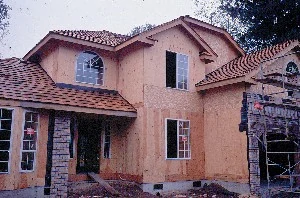Hot demand and high prices in North America have created a big market opportunity for imported wood panel products. Some of these products, however, may not live up to the quality that builders have come to expect from the North American wood structural panel industry.
APA, The Engineered Wood Association recently consulted on a residential job in Maryland and a commercial project in Pennsylvania and found that the panel products used in both were inappropriate for the job. In one case, the panels were marked with incomplete grade stamps; in the other, the panels were unmarked. In both cases, panel quality was substandard for the intended application and the panels were removed from the job sites.
In the first occurrence, Walt Schneider, P.E., with John C. Haas Associates had specified 3/4″ Plyform panels for a complicated ramp demolition/rebuild for Pennsylvania State University. The forms were in place before the demolition began and would remain through the new pour.
Workers had complained about weak panels, and when one snapped under the weight of a worker, Schneider investigated.
The panels had no grade markings, making it impossible to verify veneer grade, certification, or country of origin. The questionable panels were torn out and replaced with properly certified panels.
“This is nasty stuff,” said Schneider. “As a structural engineer, this scares the hell out of me.”
In the second instance, Bill Bryant, chief building inspector for the County of Anne Arundel in Maryland, was called to inspect some plywood panels used as wall and roof sheathing on a residence in his district. The stamp included a third-party certification trademark; however, Bryant has seen enough stamps to know that the mark didn’t look right. His instincts proved correct, as the stamp did not provide the information required by the product standard nor the building code, i.e. the certification agency trademark, span rating, thickness, and bond classification.
Bryant had the offending product torn out and replaced with properly certified product. Bryant, a veteran building official who logs upwards of 35 inspections per day, has noticed an increase in imports and questions product consistency with required quality standards. It was determined that the imported plywood in question was manufactured for non-building construction use such as pallets, but the panels had been misapplied in a sheathing application. While culpability is hard to pin on anyone in particular, a general lack of grade stamp knowledge along the distribution chain is clearly contributing to problems expressed herein.
APA remains vigilant against counterfeits and product misapplication in North America to protect builders and the public.
Why should builders care?
Engineered wood products, like many U.S. products, are manufactured under voluntary product and performance standards (PS 1-95 Construction and Industrial Plywood, PS 2-92 Performance Standard for Wood-based Structural Use Panels). The Office of Standards Services of the National Institute of Standards and Technology (NIST) assists in developing voluntary product standards on a nationwide basis through the cooperative efforts of producers, distributors, consumers, and users. Imported or off-grade products, may not meet the strict criteria necessary for the intended application. Such panels could certainly impact building durability or worse case, compromise life-safety.
Policing this threat is largely up to the professionals within the industry: code officials, builders, specifiers, designers, engineers, dealers and certification agencies all play a vital role in keeping substandard product off the market.
What’s in a Stamp
The best time to check grading stamps is when the bundles are cut. Grading agencies in the U.S. have clearly defined stamps. The typical APA stamp will have the following information:
● Certification agency trademark
● Panel grade (STURD-I-FLOOR, RATED SHEATHING, RATED SIDING or plywood grade (A-C, C-D)
● Span rating and thickness (e.g. a span rating of 32/16 means that the panel can be used for a maximum span of 32″ on a roof and 16″ on a floor)
● Exposure classification (Exposure 1 panels are suitable for wetting and drying under normal construction conditions; Exterior panels are designed for long-term exposure to weather)
● Mill number
● Product and or Performance standard (PS 1-95, PS 2-92, PRP-108)
Substandard panels often give themselves away during installation. Panels that flex excessively or break under low loads may be manufactured from species with inferior strength or with improper adhesive bonds. If builders have concerns as to the validity of the mark, contact the APA Helpline at 253-620-7400. A photo of the stamp may help us determine the source and course of action.



